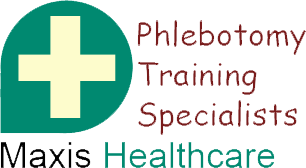Phlebotomy Training : 3 Simple Steps to Getting Your Certificate of Competency
COURSES FOR MEDICAL AND NON-MEDICAL PRACTITIONERS
25 FREE E-Lessons
1 ) Choose a course
Learn the key topics to get your phlebotomy carrer off to a flying start.Choose from two core competency training courses - "1-Day Intensive" training for medical practitioners or our very popular "2-Day A-to-Z Beginners Intensive/Start from Stratch" course for nonmedical practitioners.
2 ) Attend Theory & Dry Lab Classroom
In the class-room you will learn the key aspects of mastering phlebotomy from two qualified senior phlebotomists.
3 ) Attend Live Hospital Experience
You'll gain hands-on work experience and a CERTIFICATE OF COMPETENCY when you pass.
Courses meet all 18 competencies recommended by the NHS Skills For Health Organisation , All National Occupational Standards and "Pathway to Competency" Standards.All classroom material is NHS accrediated,and courses are taught by qualified practising senior phlebotomists.

Become A Professional Phlebotomist - ( Over 2500 students enrolled )

In the Theory + Dry Lab Session we are training students on dummy arm that can make them eligible to work on real patient.

In the Live Blood Session Students are being trained on real patients in NHS Hospital under proper supervision.
Welcome To Nhs Phlebotomy Training
Phlebotomy is Greek word which means to cut a vein . In medical science it is a process by which blood samples are collected from a living person or animal for obtaining test or either for research, transfusion or donations. Training process requires complete attention and devotion. Here are some training tips that are useful for the Phlebotomy training.
Phlebotomy and Phlebotomist Training
Most of the people who are willing to get into the medical field through phlebotomy are often confused with the training and certification methodology for being a phlebotomist although there are not very far apart, but still worth mentioning with a minor difference.
Just to clarify the basic perceptional difference in the two terms, this is related to practical and theoretical approach. Certification is more towards the theory whereas training is taken as more practical.
As many institutions are offering the certification and training programs, it is unto the candidates that how they take part in it. Although as far as the training is concerned, it can be conducted at any clinical facility under the supervision of a trained phlebotomist or a doctor who is well experienced in phlebotomy.
Sometimes it also depends on the laws of any particular state whether or not a certification is noted as more authenticated proof of a phlebotomist skill or sometime a license is required in order to perform phlebotomy. Nevertheless without proper training and certification, it is not possible to become a successful phlebotomist therefor many ways are now available in order to become one effectively.
TRAINING METHODLOGY:
Phlebotomy training varies depending on the two basic factors which are: the institution in particular and the specific program you enroll in, as phlebotomy has a few aspects of specialty.
The training does start simple with basic ability to puncture a vein and draw blood from it successfully. As the course proceeds, phlebotomists are trained and given hands-on experience about how to draw predetermined amount of blood from a body.
They learn the proper techniques and how to locate the vein that’s best for taking a sample from. Moreover, they are also trained in using a tourniquet and the knowledge of needles that works best depending on the patient’s veins.
Basic anatomy is thoroughly revised for it is crucial to understand that in order to imply that to actual patients, especially pertaining to the structure of the cardiovascular system. Few other descriptions of training includes the study of composition of blood and how to prepare them for laboratory test run.
After all of it is done, a trained phlebotomist still have to work under the supervision of a experienced Laboratory medical professional in order to attain enough practical experience. As there are many things that are taught and learned with experience.
TRAINING METHODLOGY:
After completion of training of phlebotomy, a phlebotomist can advance in the same field with different aspect of laboratory operation, such as Pharmacy Technician Certification or Clinical Medical Assistant Certification and few others. This makes the new phlebotomist more efficient and flexible with multiple domain experience of similar fields that are somewhat related, indirectly but of same branch of medical or clinical facility.



 Facebook
Facebook Twitter
Twitter Youtube
Youtube Google Plus
Google Plus Linkedin
Linkedin